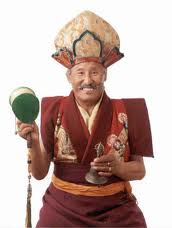Ngagpa
In Tibetan Buddhism and Bon, a Ngakpa (Tibetan: སྔགས་པ ; Wylie: sngags pa; IAST: mantrī; Sanskrit Devanagari: मन्त्री ) is a non-monastic practitioner of Vajrayana, shamanism, Tibetan medicine, Tantra and Dzogchen amongst other traditions, disciplines and arts.
Ngakpa is an alternative phonetic transcription; the Wylie is sngags pa. These terms are grammatically masculine; the feminine equivalent is Ngakma or Ngakmo. Ngak'phang is a gender neutral word that covers ngakpa and ngakmo, though this word is obscure. It may either be archaic or of relatively recent construction.
Traditionally, ngakpas wear uncut hair and white robes. From this they are referred to as gö kar chang loi de or "the white-robed and uncut-hair group" (gos dKar lCang lo'i sDe).
Description and definitions
Ngakpas often marry and have children. Some work in the world, though they are required to devote significant time to retreat and practice and in enacting rituals when requested by, or on behalf of, members of the community.
There are family lineages of Ngakpas, with the practice of a particular yidam being passed through family lineages. That said, a Ngakpa (inclusive of both sexes) may also be deemed as anyone thoroughly immersed and engaged in the practice of the teachings and under the guidance of a lineage-holder, and who has taken the appropriate vows or samaya and had the associated empowerments and transmissions.
Significant lineage transmission is through oral lore.
While Ngakpas may perform many different rituals and energetic workings; these called multi-coloured ngakpas. The white ngakpas are Dzogchen practitioners who practise mainly the inner yogas. There are then the black ngakpas rites of passage, particularly known for performing birth rituals, weddings, funerals, divinations, and pacification of ghosts or nature spirits and exorcisms. Typically, Ngagpas live with their families in villages; but many Ngagpas also congregate in dratsangs, the Ngakpa equivalent of a monastery. Some Ngakpa are comparable in practice to the Mahasidda; indeed, the Mahasidda may be correctly referred to as Ngakpa.
As scholar Sam van Schaik describes, "the lay tantric practitioner (sngags pa, Skt. māntrin) became a common figure in Tibet, and would remain so throughout the history of Tibetan Buddhism." Scholar Gyurme Dorje defines ngakpas as "a practitioner of the mantras, who may live as a householder rather than a monk."
Kunga Gyaltsen, the father Dalai Lama II Gendun Gyatso, was a non-monastic ngakpa, a famous Nyingma tantric master. His mother was Machik Kunga Pemo, they were a farming family. Their lineage transmission was by birth.
